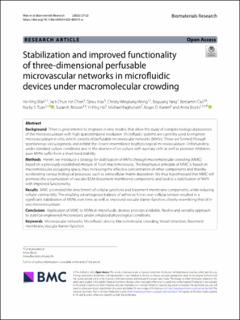Please use this identifier to cite or link to this item:
https://doi.org/10.21256/zhaw-27774| Publication type: | Article in scientific journal |
| Type of review: | Peer review (publication) |
| Title: | Stabilization and improved functionality of three-dimensional perfusable microvascular networks in microfluidic devices under macromolecular crowding |
| Authors: | Wan, Ho-Ying Chen, Jack Chun Hin Xiao, Qinru Wong, Christy Wingtung Yang, Boguang Cao, Benjamin Tuan, Rocky S. Nilsson, Susan K. Ho, Yi-Ping Raghunath, Michael Kamm, Roger D. Blocki, Anna |
| et. al: | No |
| DOI: | 10.1186/s40824-023-00375-w 10.21256/zhaw-27774 |
| Published in: | Biomaterials Research |
| Volume(Issue): | 27 |
| Issue: | 32 |
| Issue Date: | 2023 |
| Publisher / Ed. Institution: | BioMed Central |
| ISSN: | 1226-4601 |
| Language: | English |
| Subjects: | Basement membrane; Macromolecular crowding; Microfluidic device; Microvascular network; Vascular barrier function; Vessel retraction |
| Subject (DDC): | 610.28: Biomedicine, biomedical engineering |
| Abstract: | Background: There is great interest to engineer in vitro models that allow the study of complex biological processes of the microvasculature with high spatiotemporal resolution. Microfluidic systems are currently used to engineer microvasculature in vitro, which consists of perfusable microvascular networks (MVNs). These are formed through spontaneous vasculogenesis and exhibit the closest resemblance to physiological microvasculature. Unfortunately, under standard culture conditions and in the absence of co-culture with auxiliary cells as well as protease inhibitors, pure MVNs suffer from a short-lived stability. Methods: Herein, we introduce a strategy for stabilization of MVNs through macromolecular crowding (MMC) based on a previously established mixture of Ficoll macromolecules. The biophysical principle of MMC is based on macromolecules occupying space, thus increasing the effective concentration of other components and thereby accelerating various biological processes, such as extracellular matrix deposition. We thus hypothesized that MMC will promote the accumulation of vascular ECM (basement membrane) components and lead to a stabilization of MVN with improved functionality. Results: MMC promoted the enrichment of cellular junctions and basement membrane components, while reducing cellular contractility. The resulting advantageous balance of adhesive forces over cellular tension resulted in a significant stabilization of MVNs over time, as well as improved vascular barrier function, closely resembling that of in vivo microvasculature. Conclusion: Application of MMC to MVNs in microfluidic devices provides a reliable, flexible and versatile approach to stabilize engineered microvessels under simulated physiological conditions. |
| URI: | https://digitalcollection.zhaw.ch/handle/11475/27774 |
| Fulltext version: | Published version |
| License (according to publishing contract): | CC BY 4.0: Attribution 4.0 International |
| Departement: | Life Sciences and Facility Management |
| Organisational Unit: | Institute of Chemistry and Biotechnology (ICBT) |
| Appears in collections: | Publikationen Life Sciences und Facility Management |
Files in This Item:
| File | Description | Size | Format | |
|---|---|---|---|---|
| 2023_Wan-etal_Three-dimensional-perfusable-microvascular-networks.pdf | 2.87 MB | Adobe PDF |  View/Open |
Show full item record
Wan, H.-Y., Chen, J. C. H., Xiao, Q., Wong, C. W., Yang, B., Cao, B., Tuan, R. S., Nilsson, S. K., Ho, Y.-P., Raghunath, M., Kamm, R. D., & Blocki, A. (2023). Stabilization and improved functionality of three-dimensional perfusable microvascular networks in microfluidic devices under macromolecular crowding. Biomaterials Research, 27(32). https://doi.org/10.1186/s40824-023-00375-w
Wan, H.-Y. et al. (2023) ‘Stabilization and improved functionality of three-dimensional perfusable microvascular networks in microfluidic devices under macromolecular crowding’, Biomaterials Research, 27(32). Available at: https://doi.org/10.1186/s40824-023-00375-w.
H.-Y. Wan et al., “Stabilization and improved functionality of three-dimensional perfusable microvascular networks in microfluidic devices under macromolecular crowding,” Biomaterials Research, vol. 27, no. 32, 2023, doi: 10.1186/s40824-023-00375-w.
WAN, Ho-Ying, Jack Chun Hin CHEN, Qinru XIAO, Christy Wingtung WONG, Boguang YANG, Benjamin CAO, Rocky S. TUAN, Susan K. NILSSON, Yi-Ping HO, Michael RAGHUNATH, Roger D. KAMM und Anna BLOCKI, 2023. Stabilization and improved functionality of three-dimensional perfusable microvascular networks in microfluidic devices under macromolecular crowding. Biomaterials Research. 2023. Bd. 27, Nr. 32. DOI 10.1186/s40824-023-00375-w
Wan, Ho-Ying, Jack Chun Hin Chen, Qinru Xiao, Christy Wingtung Wong, Boguang Yang, Benjamin Cao, Rocky S. Tuan, et al. 2023. “Stabilization and Improved Functionality of Three-Dimensional Perfusable Microvascular Networks in Microfluidic Devices under Macromolecular Crowding.” Biomaterials Research 27 (32). https://doi.org/10.1186/s40824-023-00375-w.
Wan, Ho-Ying, et al. “Stabilization and Improved Functionality of Three-Dimensional Perfusable Microvascular Networks in Microfluidic Devices under Macromolecular Crowding.” Biomaterials Research, vol. 27, no. 32, 2023, https://doi.org/10.1186/s40824-023-00375-w.
Items in DSpace are protected by copyright, with all rights reserved, unless otherwise indicated.